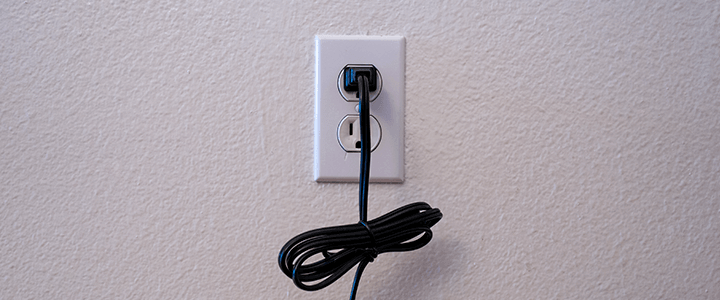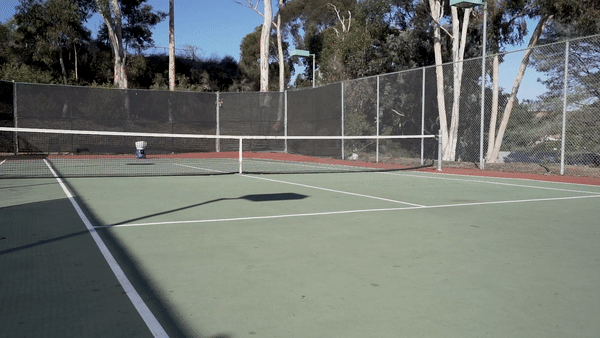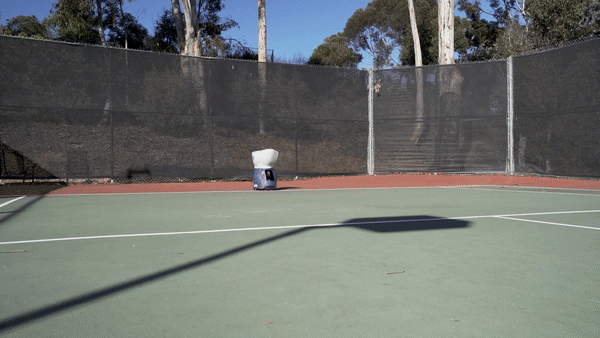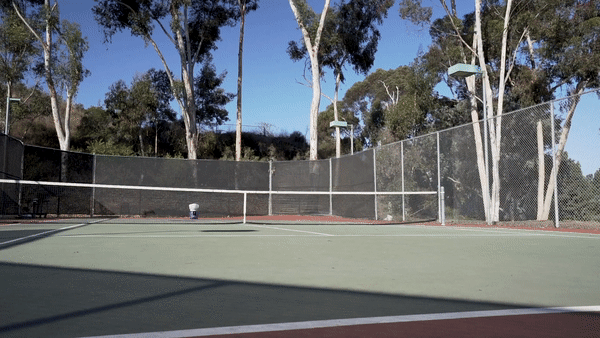7 Best Tennis Ball Machines | Reviews & Buyers Guide
Mục Lục
Features to Consider
In the world of ball machines, the cost generally ties closely to how capable the machine is and the number of features it provides.
However, a machine that offers all the bells and whistles isn’t necessarily the best tennis ball machine, and more often than not, some of the more expensive machines are overkill for most tennis players.
To help you sift through the options, I’ve compiled a list of the most common features that you’ll come across with ball machines while providing some thoughts and context on each.
Power options
Most ball machines are either battery-powered or electric through a direct connection with an outlet – a few offer both options.
Battery Powered

In my experience, the vast majority of players looking for a personal ball machine will benefit from battery-powered machines, which are portable and can easily transport anywhere you’d like to take it. Luckily, manufacturers recognize this, so the majority are available with battery power.
For the most part, you can expect to get anywhere from 2-8 hours of play time out of most tennis ball machines, which come with large batteries.
The length of play ultimately depends on how consistently you run the machine, the speed your firing the balls, and whether or not you’re actively using oscillation features if available.
From my experience, the duration of play offered by virtually all battery-powered machines is more than sufficient for one person. However, it could become a factor if multiple family members are using it daily.
Beyond the court time you can expect from a battery, you’ll also want to consider whether ‘fast’ charging is appealing. A standard charger will usually take anywhere between 8-12 hours to charge a battery fully, while a faster charger can cut that down to 3-4 hours depending on the size.
I’ve never had an issue with a standard charger because I never max out the battery when I use my machine, and I charge it right when I get home. I expect that to be true for most people.
Another feature you’ll see is smart charging, which references whether or not the charger will cease charging to protect the battery once it reaches a full charge. There was a time where this was a competitive advantage, but virtually all offer this feature now.
Last but not least, most batteries are going to last between 3-4 years and will require replacement eventually. Regularly using your machine and charging the battery will extend its life. For most, this doesn’t come as a surprise, but it’s $100 – $200 for a new battery, so worth noting.
AC Power via Electrical Outlet

Clubs or instructors have a case for using an AC electric powered ball machine if the machine is being rented or used consistently throughout the day. Even then, battery-powered machines are viable, and the club or instructor can always purchase a second battery.
Capacity

A tennis ball machine’s capacity refers to the number of balls that it can hold and fire before refilling.
As with most features, it’s a personal preference, but I’d encourage players to look for a ball machine that can hold a minimum of 50 balls, which is beneficial for two reasons.
First, if you’re continually picking up balls, it’s going to zap the fun factor pretty quickly. Second, when you’re practicing a shot, you’re often looking to establish a rhythm that you can replicate repeatedly, and 50 balls are sufficient for that purpose.
In some cases, 50 balls will be a lot for some players to hit, but it gives you room to grow into the machine, which you’ll likely appreciate over time. You’ll also want to consider whether you plan to use the ball machine with a friend or family member. You can always alternate and take turns picking up balls, but if you want to hit together, a higher capacity might make sense for you.
Another reason to consider capacity is the cost associated with purchasing tennis balls in bulk for your machine. The idea of hitting 150 balls might sound fantastic, but once you have to start buying balls for the machine, it might reduce the appeal.
For that reason, I find that a 150 ball capacity is the max most players will need, with many players only filling it partially.
Feed rate or Interval

The feed rate or interval refers to the length of time between firing each ball from the machine.
The lower the feed rate or interval, the less time a player will have between shots, making a more challenging or engaging experience.
Higher feed rates or intervals allow more time between shots, which is helpful for less experienced players.
Most tennis ball machines have variable feed rates between 2-10 seconds, so you can adjust it up or down to your preference, which is more than sufficient for the vast majority of players.
Ball Speed

Depending on your level, you may desire faster or slower ball speeds to increase or decrease the difficulty level.
Across all machines, speeds range anywhere from 10-95 mph (16-153 kph), with most machines offering between 10-65 mph (16-105 kph). A ball machine that feeds up to 65 mph (105 kph) will be more than sufficient for most players, but there are plenty of machines that feed faster if that’s important to you.
For parents evaluating ball machines, the low-end speed will likely be useful so their children can participate. Although most offer speeds as low as 10 mph, a handful of popular machines start higher around 18-35 mph, so it’s worth considering.
Spin

These days most ball machines offer topspin and backspin, but there are still a few out there that don’t provide this feature or only provide topspin.
Furthermore, some allow you to enable spin but don’t give you control over the spin’s level or strength.
I think spin is pretty important to simulate the most realistic hitting experience, but it’s certainly not a requirement, especially early on for new players.
Oscillation

Oscillation refers to a machine’s ability to feed balls at different locations throughout the court instead of to one single spot. When buying a tennis ball machine, there are three forms of oscillation to consider:
- Horizontal random: The machine can fire tennis balls at random locations from side to side while maintaining the same depth for each ball, which is useful for practicing groundstrokes or volleys.
- Vertical random: The machine can randomly fire tennis balls short and deep as you might experience from an opponent in a match.
- 2-line: Having a machine send you balls at random can be useful for more realistic practice. However, sometimes players want a more consistent feed from one side to the other, which you’ll get with the 2-line function. Many machines with 2-line feeding allow you to specify feed width, i.e., narrow, medium, wide.
Machines can often combine horizontal and vertical random oscillation to throw tennis balls at random locations throughout the court. In some scenarios, you’ll find the combination of these settings referred to as triple oscillation, i.e., combining each for a third option.
In general, oscillation is a genuinely useful feature for adding variety to the hitting experience. However, it’s also convenient because you don’t have to adjust the machine for a different shot location manually.
External vs. Internal Oscillation
Depending on the machine, it may offer external or internal oscillation.
A machine offering external oscillation will have a mechanism that moves the entire device back and forth and is visible at the bottom. On the other hand, a machine that offers internal oscillation will move the parts inside the machine. There are two reasons to consider one over the other.
First, it will be more obvious with external oscillation where the machine will feed the next ball because it will point in that direction beforehand. Compared to internal oscillation, the machine stays still, which better disguises where it will fire the next ball.
Second, machines offering external oscillation are sometimes, but not always, noisier because the mechanism sits outside.
If you’re planning on bringing a machine to public courts where others are playing nearby, then the quieter, the better.
Drills

A feature usually reserved for higher-end machines, drills are sequences of shots fed at predetermined locations, which can be useful to simulate match play or for practicing specific strategies.
Depending on the machine, the drills may include changes in the ball’s location, spin, speed, and height, or a combination of these.
- Pre-programmed: Pre-programmed drills give players added variety when using their machine while also helping to replicate scenarios or playing styles that you might encounter.
- Programmable: Programable drills allow an individual to customize the sequence of shots fed by the machine. Different machines offer varying degrees of sophistication in shot selection, which may or may not allow a player to select a location and spin, speed, and height for each shot.
- The number of shots: Some tennis ball machines allow you to set a specific number of balls to feed per programmed drill while also having a max number of shots you can record per drill.
In most cases, I’d consider the drill features offered by most machines to be overkill relative to the added cost. However, many players appreciate the added variety, so you have to weigh the option.
Hopper Window

A less meaningful yet useful feature offered on some ball machines is a window or slots at the front of the hopper, which helps you keep track of how many balls remain before needing to pick up.
Some companies have leaned in on semi-transparent hopper windows for more visibility into how many balls are left.















![Toni Kroos là ai? [ sự thật về tiểu sử đầy đủ Toni Kroos ]](https://evbn.org/wp-content/uploads/New-Project-6635-1671934592.jpg)


